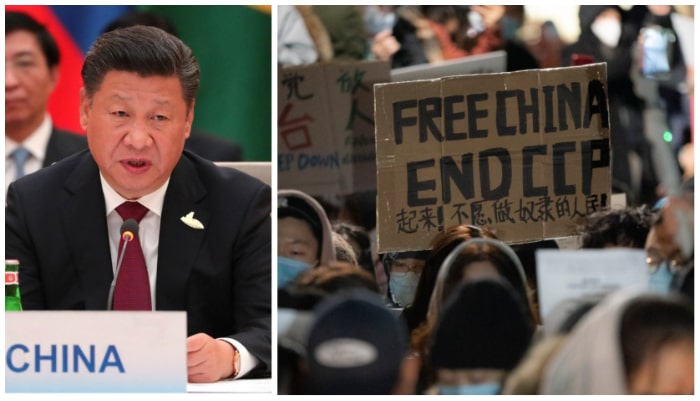CCP’s tight control over public expressions of discontent
Under the Chinese Communist Party’s (CCP) leadership, the Chinese government has been known to forcefully quell opposition from various societal factions. This is evident in the recent peaceful protests by Tibetan Buddhist Lamas and students, which were met with strong suppression, underscoring the government’s hardline stance against dissent and its tight control over public expressions of discontent.
A Tibetan university was shut down for an extended period, and its students were subjected to strict control, culminating in collective protests last week. Tragically, over 20 students died when local police, numbering in the hundreds, were deployed to violently suppress the protesters. While the mainland media remained silent on the incident, some students disclosed the details to NTDTV.
The closure of Tibetan universities was initiated since 2008, following a rally where Tibetans protested against the CCP Authority’s arrest of marching monks against human rights abuses. The rally was met with violent suppression by armed police, resulting in nearly 100 casualties, an event now referred to as “the March 14 incident.” This led to the gradual annual closure of local colleges and universities. Lhasa Normal College, the sole university directly under the Tibetan capital, enforced this closure measure with particular severity. Insiders revealed that this year’s extended closure was triggered by a female student who exposed the closure to overseas media, garnering widespread attention.
The female student was taken into police custody, and her current whereabouts are unknown. In addition, the school and police conducted extensive investigations on thousands of students. An informant revealed that over 30 students were detained afterward for accessing their Google mail via an external network to apply for foreign universities, as domestic mail services were deemed insufficient.
Those familiar with the situation described the control measures at Lhasa Teachers College as prison-like conditions. The campus was enclosed by barbed wire fences, and steel pipes were installed in classrooms. Six students were barred from seeking treatment outside the infirmary and were limited to eating only in the cafeteria. Moreover, the school’s cafeterias and supermarkets monopolized prices, significantly inflating them. A student noted the arbitrary price hikes, with a cup of soy milk priced at 7 Yuan and a simple steamed bun selling for 15 Yuan. Some students attempted to petition the principal to shorten the closure period but were met with threats. The principal warned that continued protests would result in police intervention, with students being treated as state criminals or spies.
One student recounted that 120 students collectively signed the petition and submitted it to the principal, who refused to acknowledge it and tore it up. He then went from class to class to identify the signatories, and they were all punished accordingly. On March 16th, a collective protest erupted at Lhasa Teachers College. 500 students gathered in the playground demanding to see the principal. However, instead of the principal, they were met by hundreds of armed police force. An insider recounted that the police used batons as weapons and began assaulting the students. Two students were fatally beaten on the spot amidst the chaos, and several others suffered severe injuries. Some were even trampled to death. Protesters held CCP responsible for the deaths of three students, but in reality, over a dozen individuals lost their lives.
The Communist government of China and Xi Jinping are well aware that if even a single successful rebellion occurs in any part of China, it would overturn the entire Chinese society. In such a scenario, the risk of the Communist regime being overthrown would be the highest. Therefore, the Communist Party does not want any kind of movement to turn into a rebellion. This is why when a large crowd of the Buddhist Lamas in Tibet peacefully protested against the government on human rights issues, the Chinese police brutally suppressed it.
Reports of such occurrences undeniably find their way into the international press, yet the media outlets under the control of CCP maintain a conspicuous silence on these matters. The CCP is keen to prevent the dissemination of such news within its borders, apprehensive of the potential for protests to escalate into full-blown rebellions. Concurrently, China’s track record concerning human rights abuses is notably dismal on the global stage. Nevertheless, China remains unflinchingly prepared to quell any form of dissent within its territory, seemingly indifferent to its international reputation.
In the aftermath of the severe quelling of student demonstrations, the CCP implemented a strict surveillance system, deploying CCTV cameras across multiple locations to keep a vigilant eye on student activities. The students were directed to utilize a specific mobile application, enabling law enforcement to maintain stringent surveillance over their movements. In essence, the CCP has instituted comprehensive measures to stifle any form of insurrection, demonstrating their unwavering resolve to maintain control.
The CCP generally employs a dual-pronged approach to stifle student-led demonstrations in colleges. The initial strategy encompasses the closure of academic institutions, thereby inhibiting the assembly of students. The subsequent method, markedly harsh and ruthless, entails the deployment of law enforcement to suppress these protests. Furthermore, an array of constraints is levied upon the students, compelling them to confine their activities within the university premises, including mandatory meals at the college canteen. The students find themselves in an environment reminiscent of incarceration, effectively sapping their resolve to voice dissent or engage in protest against the governing body.
Under these daunting circumstances, students grapple with formidable challenges. The Chinese government maintains a stance of apathy, even in the face of student fatalities during protests. Despite the stringent internet censorship imposed by the Chinese authorities, Tibetan students persist in their efforts to broadcast the repressive measures undertaken by the Chinese government in Tibet, leveraging foreign media as a conduit to inform the global community.











